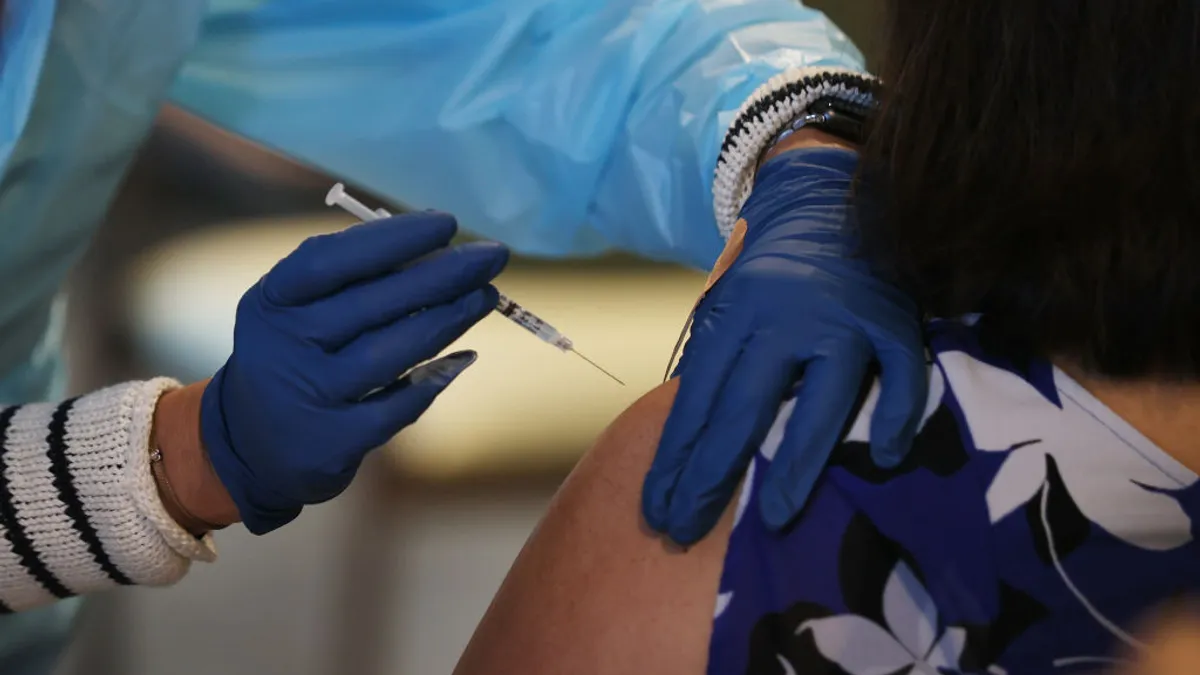Dive Brief:
- Most employers "no longer need to take steps to protect their workers from COVID-19 exposure in any workplace, or well-defined portions of a workplace, where all employees are fully vaccinated," OSHA said in guidance updated Thursday.
- The agency also published an emergency temporary standard for U.S. healthcare employers. Employers included in the emergency temporary standard's definition must develop and implement a plan to protect employees from COVID-19 in the workplace, and they must designate one or more workplace COVID-19 safety coordinators to implement and monitor their plans.
- OSHA's updated guidance for all industries, meanwhile, encourages employers to grant paid time off for employees to get vaccinated. Employers also should implement physical distancing for unvaccinated and other at-risk workers in communal work areas, including limiting the number of such workers in one place at any given time.
Dive Insight:
The updated guidance may help to resolve some of the questions employers had following a May update from the Centers for Disease Control and Prevention that, with some restrictions, fully masked individuals could resume activities without wearing a mask. Last month, OSHA directed employers to follow CDC's guidance on mask use and social distancing for fully vaccinated workers.
OSHA's June 10 announcement has drawn a range of reactions from observers. While praising the healthcare industry temporary emergency standard as a "step in the right direction," House Committee on Education and Labor Chairman Robert C. "Bobby" Scott, D-Va., criticized the Biden administration for not providing other specific guidance for employers in other industries.
"This ETS is long past due, and it provides no meaningful protection to many workers who remain at high risk of serious illness from COVID-19," Scott said in an email press release. "Workers in meat processing plants, prisons, homeless shelters, grocery stores, and many other workplaces will be forced to continue relying on voluntary safety guidance, which has failed to protect hundreds of thousands of workers and families from preventable infections throughout the pandemic."
In a statement emailed to Construction Dive, Associated General Contractors of America President Stephen Sandherr said that the fact the final standard only applies to healthcare settings is a "significant victory" for the construction industry. The association had long questioned the need for an ETS for construction, saying the widespread availability of the COVID-19 vaccine and the industry's coronavirus safety protocols negated the need for a nationwide standard.
Nevertheless, OSHA had long faced pressure from worker advocates to publish emergency standards addressing how to protect workers' health and safety from COVID-19 in the workplace. Following the release of the agency's initial guidance on Jan. 29, an official at the National Council of Occupational Safety and Health said that "OSHA and our federal government has failed us," citing insufficient workplace inspections and data recording practices, Construction Dive reported.
Attempts to get the agency to publish emergency standards even involved a lawsuit filed last year by the AFL-CIO, but a federal appeals court declined to compel OSHA to do so.
In addition to the guidance published by CDC and OSHA, the U.S. Equal Employment Opportunity Commission said in a technical assistance document updated May 28 that employers may implement policies requiring that all employees who physically enter a workplace receive a COVID-19 vaccination under federal equal employment opportunity laws, with some exceptions.
















